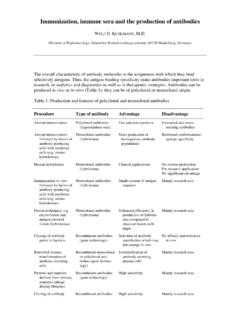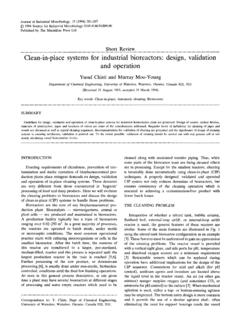Transcription of Generation of an alpaca-derived nanobody …
1 MethodGeneration of an alpaca - derived nanobody recognizingc-H2 AXMalini Rajana, Oliver Mortusewiczb,1, Ulrich Rothbauerc, Florian D. Hasterta, Katrin Schmidthalsd,Alexander Rappa, Heinrich Leonhardtb, , M. Cristina Cardosoa, aDepartment of Biology, Technische Universitaet Darmstadt, GermanybBiozentrum, Department of Biology II, Ludwig Maximilians Universitaet Munich, GermanycPharmaceutical Biotechnology, Eberhard-Karls University Tuebingen, GermanydChromotek GmbH, Munich, Germanyarticle infoArticle history:Received 11 July 2015 Revised 9 September 2015 Accepted 16 September 2015 Keywords:ChromobodiesDNA repairPost-translational modificationsLive cell microscopyAlpaca heavy chain antibodiesLaser microirradiationabstractPost-translation al modifications are difficult to visualize in living cells and are conveniently ana-lyzed using antibodies. Single-chain antibody fragments derived from alpacas and called nanobod-ies can be expressed and bind to the target antigenic sites in living cells.
2 As a proof of concept, wegenerated and characterized nanobodies against the commonly used biomarker for DNA doublestrand vitroandin vivocharacterization showed the specificity of thec-H2 AXnanobody. Mammalian cells were transfected with fluorescent fusions called chromobodies andDNA breaks induced by laser microirradiation. We found that alternative epitope recognition andmasking of the epitope in living cells compromised the chromobody function. These pitfalls shouldbe considered in the future development and screening of intracellular antibody biomarkers. 2015 The Authors. Published by Elsevier on behalf of the Federation of European Biochemical Societies. Thisis an open access article under the CC BY-NC-ND license ( ).1. IntroductionDamage to the DNA is a common event occurring in the life of acell due to exogenous factors like viruses, carcinogens, differenttypes of radiation, other environmental factors and endogenousfactors.
3 These damages may lead to mutations in DNA, causingcancer and other harmful effects to the cell. Hence, the study of cel-lular DNA damage is very important and requires extensive data onthe modification, localization and interaction of cellular compo-nents. Phosphorylation on serine 139 of histone H2AX (c-H2AX)is associated with DNA double strand breaks (DSBs)[1]. Its ampli-fication and signalling function in recruiting other repair factors tothe site of damage and its removal after damage repair is com-pleted, makesc-H2AX the most sensitive biomarker used to studyDNA DSBs. Existing methods are based on antibody staining andtheir application is not suitable for live cells. Though microinjec-tion or bead loading of antibodies is possible for live cell analyses[2], it is not commonly used due to antibody aggregation and tox-icity problems as well as nuclear accessibility. Fluorescent fusionproteins allow live cell kinetic measurements but in general cannotbe used to distinguish post-translationally modified derivatives ofectopically expressed proteins, albeit, to a certain extent, GFP fused53BP1 has been used as a surrogate marker forc-H2AX foci[3].
4 Recent reports have demonstrated the isolation of the cDNAs cod-ing for the variable regions of the IgG heavy and light chains fromhybridoma cell lines and the feasibility of their expression in mam-malian cells as fluorescent fusion intracellular antibodies[4]. Theneed for the isolation of both matched cDNAs (light and heavychain variable fragments) and to select the appropriate 2015 The Authors. Published by Elsevier on behalf of the Federation of European Biochemical is an open access article under the CC BY-NC-ND license ( ).Abbreviations:VHH, variable domain of heavy-chain antibody; H2AX, histoneH2AX; MDC1, mediator of DNA damage checkpoint-1; MEF, mouse embryonicfibroblast; GFP, green fluorescent protein; RFP, red fluorescent protein; HEK293,human embryonic kidney 293 cells; siRNA, short interfering RNA; XRCC1, X-rayrepair cross-complementing protein 1; CKM, casein kinase 2 mutant; ELISA, enzymelinked immunosorbent assay; KLH, keyhole limpet hemocyanin; FRAP, fluorescencerecovery after photobleaching Corresponding authors at: Biozentrum, Ludwig Maximilians University Munich,Gro hadernerstr.
5 2, 82152 Planegg-Martinsried, Germany. Tel.: +49 (0)89 2180 74232; fax: +49 (0)89 2180 74 236 (H. Leonhardt). Department of Biology, TechnischeUniversit t Darmstadt, Schnittspahnstr. 10, 64287 Darmstadt, Germany. Tel.: +49(0)6151 16 21882; fax: +49 (0)6151 16 21880 ( Cardoso).E-mail Cardoso).1 Present address: Science for Life Laboratory, Division of Translational Medicineand Chemical Biology, Department of Medical Biochemistry and Biophysics, Karolin-ska Institutet, S-171 21 Stockholm, Open Bio 5 (2015) 779 788journal homepage: to create a functioning fusion of the heavy and light chainvariable fragments together with a fluorescent protein, makes thisa very difficult and challenging , we introduce a novel technology with the aim of studyingDNA double strand breaks based on recognition of post-translational modifications of H2AX in living cells. Sera of llamasand camels were found to have both conventional heterote-trameric and also heavy chain only antibodies.
6 These heavy chainantibodies possess a single variable domain (VHH) and two con-stant domains CH2 and CH3[5]. The antigen binding domains ofheavy chain antibodies (VHH), known as nanobodies, are of smallsize (between 12 and 15 kDa) and retain fully functional antigen-binding capacity. These domains can be chemically conjugated tofluorophores or genetically fused with fluorescent tags and subse-quently expressed in living cells. Such fluorescently labeled intra-bodies, which are called chromobodies, can be used to detect andtrace proteins as well as other cellular componentsin vivo[6,7].The paratope of nanobodies often adopts a convex-shaped confor-mation, which allows it to access differently shaped epitopes easierthan the flat paratope of conventional antibodies. Nanobodies arevery stable, monomeric and their highly soluble nature in aqueoussolutions makes them easy to purify on a large scale in heterolo-gous expression systems[8 10].
7 Their antigen binding affinitiescan reach subnanomolar range[11]and they possess high stabilityover a wide range of temperatures and show a very good resistanceto chemical and thermal denaturation compared to their conven-tional counterparts[12 14]. Based on the choice of the epitope,chromobodies can be used to detect endogenous factors anddynamic events occurring in the living cell. In principle, any anti-genic property including post-translational modifications or non-protein structures can be expand our present understanding of DNA DSBs, we devel-oped ac-H2AX nanobody /chromobody that can specifically detecthistone H2AX phosphorylated on serine 139 and characterize itsbindingin vitroandin Material and Quick outline for the production of chromobodies(1) An alpaca (Llama pacos) was immunized withc-H2AX pep-tide coupled to KLH (keyhole limpet hemocyanin) (Fig. 1A).About two months later, serum was isolated by centrifuga-tion of blood (2000 rpm, 10 min and 4 C).
8 Immunizations of alpacas for the purpose of generating anti-bodies were approved by the Government of Upper Bavaria,according to the animal experimentation law, permit num-ber (2) To test for an immune response, an ELISA test was per-formed on the serum. 96-well plates (Maxisorp, Thermo Sci-entific GmbH, Schwerte, North Rhine-Westphalen,Germany) were coated with 1lg of the antigen and theserum was added in serial dilutions. Bound alpaca antibod-ies were further detected with HRP-conjugated anti-alpacaIgG antibody (Bethyl Laboratories Inc, Montgomery, Ala-bama, USA).(3) Upon positive ELISA test, B cells were isolated with a Ficollgradient using UNI-SEPMAXI (Novamed Ltd., Jerusalem,Israel).(4) From the B cells, RNA was extracted with the TRIzol reagent(Life Technologies, Carlsbad, California, USA) according tothe manufacturer s protocol.(5) From this RNA, complementary DNA (cDNA) was generatedusing the First-Strand cDNA Synthesis Kit (GE Healthcare,Uppsala, Sweden) according to the manufacturer s protocol.
9 (6) VHHs were amplified by three sequential PCR was used as the DNA template for the first PCR. Forthe PCR reactions, the following primers were used:1st PCR:Forward primer CALL001:50-GTC CTG GCT GCT CTT CTA CA A GG-30 Reverse primer CALL002:50-GGT ACG TGC TGT TGA ACT GTT CC-30;2nd PCR:Forward primer SM017:50-CCA GCC GGC CAT GGC TCA GGT GCA GCT GGT GGA GTCTGG-30 Reverse primer SM018:50-CCA GCC GGC CAT GGC TGA TGT GCA GCT GGT GGA GTCTGG-30;3rd PCR:Forward primer A4short:50-CAT GCC ATG ACT CGC GGC CAC GCC GGC CAT GGC-30 Reverse primer 38:50-GGA CTA GTG CGG CCG CTG GAG ACG GTG ACC TGG GT-30.(7) The amplified product and the plasmid vector pHEN4 weredigested with NotI and NcoI restriction enzymes, thus pro-ducing compatible overhangs to ligate.(8) Electro-competent TG1 cells (Agilent Technologies GmbH & , Waldbronn, Baden-Wuerttemberg, Germany) wereused to generate VHH libraries. They were transformed byelectroporation with the ligation preparations performedaccording to the manufacturer s protocol.
10 (9) The transformed TG1 cells were incubated with hyperphage(Progen Biotechnik GmbH, Heidelberg, Baden-Wuerttemberg, Germany). The phage particles presentingthe VHH library on their tips were collected.(10) Solid phase panning is a conventional method to enrich forphages containing the antibody fragments from the wholelibrary. Initially immunotubes were coated with 10lgofthe antigen at 4 C. Phage particles were added to themand incubated for h at room temperature.(11) The bound phages were eluted with M triethylamineover four rounds of panning and used for reinfection ofTG1 cells, which were then used for the subsequent Phage ELISAP hage ELISA was used to measure the binding and confirm thespecificity to the antigen of the phages selected in the panningmethod described above. Initially 1lg of antigen was coated onto96 well plates. After blocking with 3% milk in PBS, phage particleswere added to the plates coated with antigen and incubated atroom temperature for 2 h.







